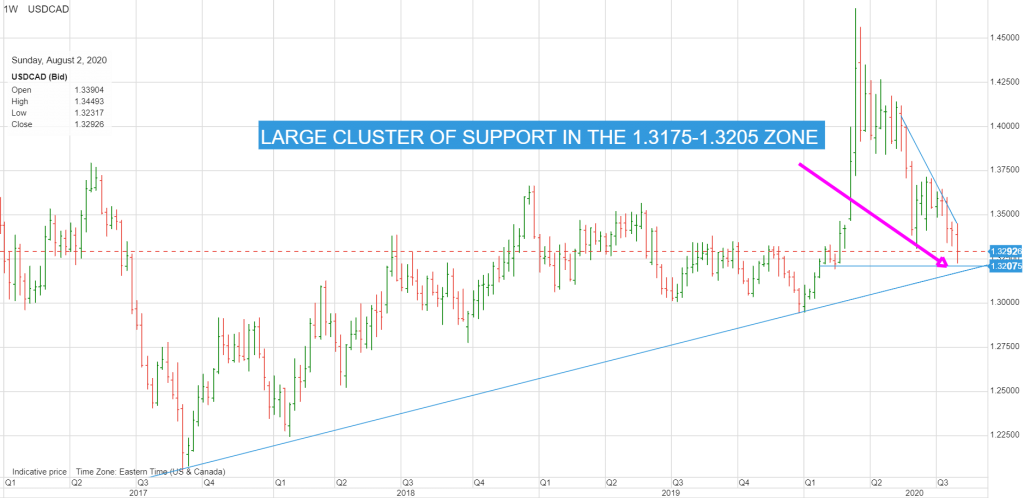
Photo: Pixabay
August 6, 2020
USDCAD Open (6:00 am) 1.3269-73, Overnight Range 1.3246-1.3301
- US Initial Jobless Claims beat forecasts, rise 1.186 million
- Bank of England leave rates and policy unchanged-no surprise.
- German June Factory Orders rise 27.9% m/m
- GBP is the outlier, as US dollar opens flat

Source: Saxo Bank/IFXA Ltd
The US Department of Labour Statistics announced that weekly jobless claims dropped by 249,000 from the previous week. The US dollar dipped following the news.
Overnight, FX markets didn’t stray too far from where they closed, Wednesday. The US government is hanging unemployed workers out to dry, as election gamesmanship thwarts attempts for a replacement for the CARES Act. COVID-19 flare-ups in France, Britain and in the US are cause for concern, as are ongoing China and “most of the free-world” hostilities. It wasn’t enough to spark a US dollar rally, but it put the brakes to broad US selling.
The major Asian equity indexes closed with small losses, and European bourses are also in the red. US equity futures flipped from negative to positive after todays US data. WTI oil traded in a $41.64-$42.42/barrel range, underpinned by the weak US dollar and Wednesday’s news that US crude inventories fell by 7.37 million barrels. Gold (XAUUSD) traded steady in a $2043.89-$2064.71 range supported by the weak US dollar, low global interest rates, and a dash of safe-haven demand from geopolitical tensions.
EURUSD rallied, albeit choppily, in a 1.1839-1.1915 band. It peaked after the German Factory Orders data was released, then profit taking drove prices to the overnight low. EURUSD has risen on the back of negative US dollar sentiment stemming from US political dysfunction, the resurgence of coronavirus cases in many US states and the perception that the European economy will outperform the US economy in the second half of the year. However, the magnitude of recent gains and the risk of a correction with nonfarm payrolls looming is making traders cautious.
USDJPY traded sideways in a 105.40-68 band. Wednesday’ weak ADP data and soft US Treasury yields weighed on prices.
AUDUSD and NZDUSD moves mirror US dollar sentiment. Both currency pairs are lower on the back of profit-taking ahead of Friday’s NFP data, following this week’s strong gains.
USDCAD dropped to 1.3235 yesterday, just above support in the 1.3230 area. It held and prices bounced to 1.3288 overnight. USDCAD is punching above its weight. The currency pair is free-loading on the broad-US dollar sell-off. Yesterday’s ADP report was weak, and though a poor barometer of NFP, still raises concerns that Friday’s NFP report may be weaker than expected.
A weak US economy is not helpful for the Canadian outlook, either. The US dollar is suffering from the belief that the European economy will outperform the US economy because of the rise in COVID-19 cases in America. However, the new case numbers are declining. Canada has its version of a political crisis with calls for the Finance Minister to resign. The Alberta oil patch got hit with another blow last week when Total Petroleum, wrote down $9.5 billion in oilsands assets. If they don’t see hope in Canada’s energy industry, who will?
There is not any Canadian economic data due today.
USDCAD Technicals: The intraday USDCAD technicals are modestly bullish above 1.3240, looking for further gains to 1.3330. Longer, term, the down trend line from May is intact while prices are below 1.3460. The weekly chart highlights a cluster of support from the uptrend line from 2017 and multi-bottoms in the 1.3190-1.3205 area since January 2020. For today, USDCAD support is at 1.3240 and 1.3210. Resistance is at 1.3310 and 1.3330. Today’s Range 1.3230-1.3310
Chart: USDCAD weekly

Source: Saxo Bank





